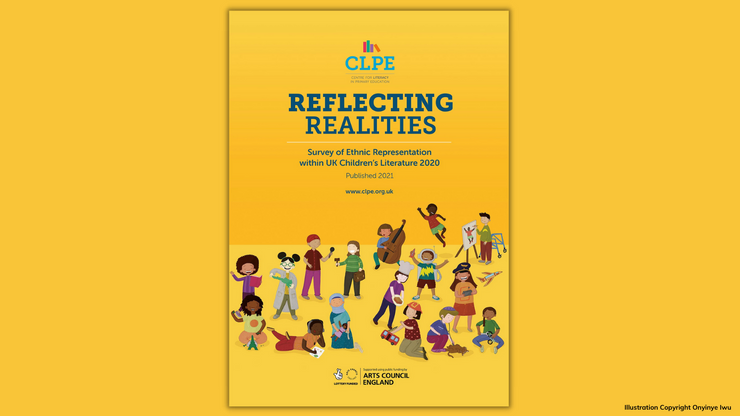Today (4th November) the Centre for Literacy in Primary Education (CLPE) release their 4th annual Reflecting Realities Survey of Ethnic Representation within UK Children’s Literature, which identifies and evaluates representation within picturebooks, fiction and non-fiction for ages 3–11. The newly published report can be viewed here and you can read more about the methodology behind the report here.
The latest summary of findings shows an increase in children’s books featuring a minority ethnic character – from 10% in 2019 to 15% in 2020. Minority representation in children’s books is up significantly from the 4% reported in the inaugural report in 2017. Furthermore, the percentage of children’s books published featuring a main character from a minority ethnic background has increased from 1% to 8% in the same time period. While the increase is cause for celebration – it still needs to be considered in the context that 33.9% of children of primary school age in England are from a minority ethnic background, and there is much work still to do.
The survey also indicates a significant increase in representation in picturebooks and non-fiction – but the percentage of characters from a minority ethnic background in other fiction remains static. The percentage of minority ethnic representation in picturebooks strides far ahead of non-fiction and fiction.
Another interesting finding from the survey was the increase in the number of funny books featuring minority ethnic characters. The volume of comedy titles in which characters of colour are located has continued to grow each year, from just one title in the first report to 10% of this year’s submissions.
The report aims to highlight a few of the numerous initiatives across the publishing and charity sectors that have partnered with CLPE in working for positive change in this area, although there are of course many more teachers, booksellers, librarians, book champions and organisations doing excellent work on the ground on a day-to-day basis. Helpfully, the report writers offer a few key pointers for those involved in children’s publishing, curation and book selection:
Characters of colour should reflect the UK population and the world at large, not as a tick box exercise but as a meaningful and accurate representation of the interconnected, diverse society within which our children are growing up.
Content should be balanced, allowing for cultural specificity without reducing characterisations to derogatory stereotypes or one dimensional shorthand
Characters of colour need to be well developed and authentically portrayed
Characters of colour should not be predominantly defined by their struggle, suffering, exceptionalism or ‘otherness
Characters of colour should be central to a broad range of narratives
Characters of colour should exist across a range of genres and within both fiction and non-fiction, allowing readers to experience the full spectrum of emotions when enjoying these representations
Thorough research and careful consideration should be exercised to ensure respectful, nuanced and layered portrayals
The industry should continue to invest in both established and new authors from a range of backgrounds who are able to paint characters and worlds with the integrity that the subject matter deserves.
CLPE also announced a ground-breaking research project to show the importance of Reflecting Realities in primary school classrooms. The project will test what happens when children have the opportunity to engage with quality representative literature and will track the impact on their reading and writing. The initial findings from this work will be published by Sage in a new book from CLPE in 2023.
There is still some way to go before UK children’s books more accurately reflect the reality of the school population of England, but the speed of change serves to reinforce the benefit and tangible impact of the survey and a wide range of other initiatives across the publishing, charity and literature sectors.
CEO of CLPE Louise Johns-Shepherd, says:
‘Every year we say, this work is not just about the numbers, and we say it again this year. We can see that, across the industry there are real and concerted efforts to change the quality of pictures, descriptions and stories of people from racialized minorities. We welcome these changes but we are not yet at the point where children of colour have the same experience of literature as their white peers. The survey shows us that work is still needed and this report highlights those areas and makes recommendations for future and further development.’
To view the full version of CLPE’s Reflecting Realities Survey of Ethnic Representation within UK Children’s Literature click here.
If you are interested in expanding your stock of diverse book titles, why not browse our diversity hub featuring booklists covering across the primary age range?
Where next? > Visit our Reading for Pleasure Hub
> Browse our Topic Booklists
> Go to our Diversity Booklists
> View our printable year group booklists.
> See our Books of the Month.









